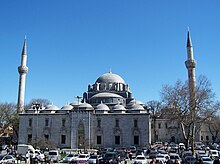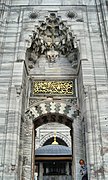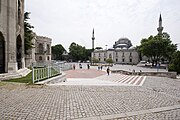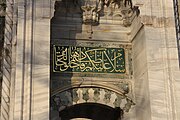Bayezid II Mosque, Istanbul
| Bayezid II Mosque | |
|---|---|
 | |
| Religion | |
| Affiliation | Sunni Islam |
| Location | |
| Location | Istanbul, Turkey |
 Location within the Fatih district of Istanbul | |
| Geographic coordinates | 41°00′37″N 28°57′55″E / 41.01028°N 28.96528°ECoordinates: 41°00′37″N 28°57′55″E / 41.01028°N 28.96528°E |
| Architecture | |
| Architect(s) | Mimar Hayruddin |
| Type | mosque |
| Groundbreaking | 1501 |
| Completed | 1506 |
| Specifications | |
| Length | 40 metres (130 feet) |
| Width | 40 metres (130 feet) |
| Dome height (outer) | 44 metres (144 feet) |
| Dome dia. (inner) | 16.78 metres (55.1 feet) |
| Minaret(s) | 2 |
| Materials | granite, marble |

The Bayezid II Mosque (Turkish: Beyazıt Camii, Bayezid Camii) is an early 16th century Ottoman imperial mosque located in the Beyazıt Square area of Istanbul, Turkey, near the ruins of the Forum of Theodosius of ancient Constantinople.
History[]
The Beyazidiye Camii was commissioned by Ottoman Sultan Bayezid II, and was the second large imperial mosque complex to be erected in Istanbul after the conquest. As the earliest complex, the Fatih Mosque was subsequently destroyed by earthquakes and completely rebuilt in a different style, the Beyazidiye complex is of considerable historical and architectural significance.[1]
The mosque was constructed between 1500 and 1505.[2] The külliye (religious and charitable complex) of the mosque includes a nearby medrese (madrasa), completed in 1507, a large hamam (bathhouse), completed some time before 1507, an imaret (public kitchen), a caravanserai, and several mausoleums including the türbe of Bayezid II himself. The architect of the complex is not firmly established but Yakubşah ibn Islamşah is believed to have been chief architect, though Mimar Hayreddin is also named. At least one of Yakubşah's assistant architects succeeded him to finish the medrese.[2] That the architect was a nephew of the Greek architect of the Fatih Mosque (Atik Sinan or Christodoulos), is known from a grant of Bayazid II.[3] This grant confirms the endowment by Mehmed II of the Greek orthodox Church of Saint Mary of the Mongols, the only church in Istanbul never converted into a mosque, to the mother of Christodoulos (the Bayezid II Mosque's architect's grandmother) in acknowledgment of the two architects' work.[3] Little else is known about the architect other than that he also built a caravansarai in Bursa; however, the polished style of the mosque itself indicates experience with earlier Ottoman and western architectural techniques.[4]
Damages and Restoration Works[]
The dome was partially rebuilt after an earthquake in 1509,[2] and Mimar Sinan conducted further repairs in 1573–74.
The minarets were burned separately by a fire in both 1683 and 1754. They were also damaged by a lightning strike in 1743. A document dated October 1754 states that a special type of stone -od stone- was brought from Karamürsel city of Kocaeli, for repair of the mosque.[5] Also, an inscription above the courtyard entrance suggests that repairs were also conducted in 1767, as consequence of the earthquake which struck Istanbul one year before.[2]
An extensive restoration work was started in August 2012. The process took 8 years. Cemented formations made in previous repairs throughout the mosque were removed, and damaged materials were either cleaned or replaced. The restoration, which involved a team of approximately 150 people and cost 49 million Turkish Liras (approximately 7.2 million US dollars), was completed in May 2020 and the mosque was opened to worship at full capacity again. [6]
Architecture[]
Exterior[]
The mosque is oriented along the northwest-southeast axis with a courtyard to the northwest with an area almost equal to that of the mosque itself. the courtyard has monumental entrance portals on each side. The courtyard is a colonnaded peristyle, with twenty ancient columns of porphyry, verd antique and granite salvaged from churches and ancient ruins, roofed with 24 small domes, and with a pavement in polychrome marble.
The mosque itself is approximately 40 metres (130 feet) square, with a 16.78-metre (55.1-foot) diameter dome. The design is that of a central dome held by two semi-domes along the main axis and two arches running along the secondary axis. The mosque is constructed entirely of cut stone appropriating colored stones and marbles appropriated from nearby Byzantine ruins.
Interior[]

The interior of the mosque is patterned after the Hagia Sophia on a smaller scale.[1] In addition to the huge central dome, semidomes to the east and west form a nave, whereas to the north and south extend side aisles, each with four small domes which extend the length of the mosque, but which are not divided into galleries. The dome is supported by huge rectangular piers, with smooth pendentives and stalactite decorations. The space is lit with twenty windows at the base of the dome and seven windows on each semi-dome, in addition to two tiers of windows on the walls.
On the west side, a broad extended corridor extends considerable beyond the main structure of the building. Originally designed as four domed rooms to serve as a hospice for wandering dervishes, the wings were integrated into the prayer hall in the sixteenth century and now consist of three consecutive rooms separated by archways.[7] At the ends of these wings are the two minarets.
Grounds[]
Behind the mosque is a small garden, containing the türbe (tombs) of Sultan Bayezid II, his daughter Selçuk Hatun, and Grand Vizier Koca Mustafa Reşid Pasha.[1] Below the garden is an arcade of shops whose rents were originally intended to support the mosque. This arcade was designed by Mimar Sinan in 1580 and extensively restored in the 1960s. The former public kitchens of the mosque was converted into the State Library of Istanbul by Sultan Abdulhamid II in 1882 and houses over 120,000 books and 7000 manuscripts. Likewise, the former madrasah now houses the Istanbul Municipal Library.[citation needed] The monumental Bayezid II Hamam was restored in the 2000s and early 2010s before being reopened as the Museum of Turkish Hamam Culture in 2015.[8]
Gallery[]
Dome of the Bayezid Mosque
Interior of the mosque
A calligraphic inscription above a door to the mosque

Gate

Courtyard

Beyazid II mosque from stairs of university entrance

Beyazid II mosque entrance courtyard

Beyazid II mosque tombs

Beyazid II mosque interior

Beyazid II mosque interior

Beyazid II mosque domes
See also[]
- Ottoman architecture
- Islamic architecture
- List of mosques
Notes[]
- ^ Jump up to: a b c Freely, Blue Guide Istanbul pp. 151–153
- ^ Jump up to: a b c d Kuban, Doğan (2010). Ottoman Architecture. Antique Collectors' Club. pp. 200–206.
- ^ Jump up to: a b Van Millingen, Alexander (1912). Byzantine Churches of Constantinople. London: MacMillan & Co., p. 276.
- ^ Owsenwald, The Middle East, pp.211
- ^ "2. Bayezid Camii ve Külliyesi" (in Turkish).
- ^ "5 asırlık Beyazıt Camisi 8 yıllık restorasyonla ihya edildi" (in Turkish).
- ^ Bayezid II Complex Archived September 16, 2008, at the Wayback Machine, ArchNet.
- ^ Üniversitesi, İstanbul. "İstanbul's Largest Bath: İstanbul University II. Bayezid Turkish Bath (Hamam) Museum". www.istanbul.edu.tr. Retrieved 2020-10-09.
References[]
| Wikimedia Commons has media related to Bayezid II Mosque. |
- Freely, John (2000). Blue Guide Istanbul. W. W. Norton & Company. ISBN 0-393-32014-6.
- Ochsenwald, William (2003). The Middle East: A History. McGraw-Hill Humanities. ISBN 0-07-244233-6.
- Sultan Bajazid's (i.e., Beyazit's) Mosque, Constantinople, Turkey
- Fatih
- Ottoman mosques in Istanbul
- Religious buildings and structures completed in 1506
- Madrasas in Turkey
- Sunni mosques in Turkey
- Mimar Hayruddin buildings
- 16th-century mosques
- 16th-century madrasas















